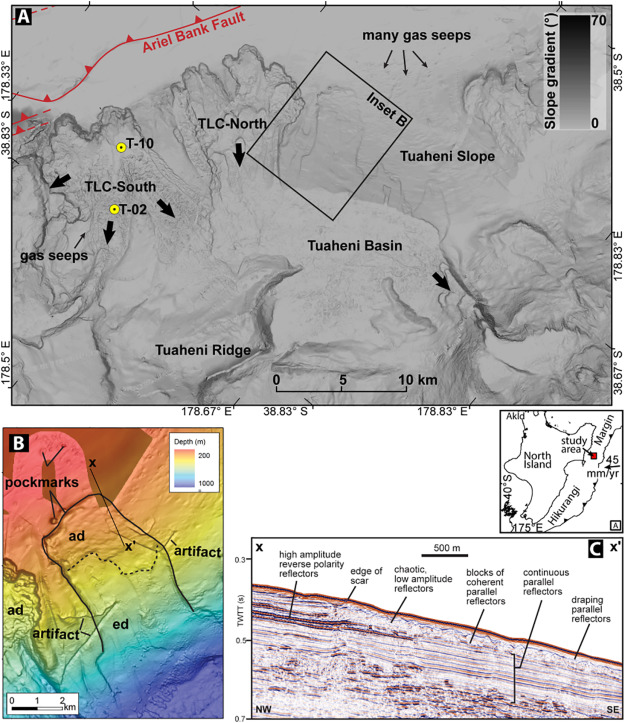8 February 2019
Submarine landslides can creep too – my latest paper
Posted by Dave Petley
Submarine landslides can creep too – my latest paper
In comparison with terrestrial mass movements, submarine landslides are surprisingly poorly investigated, despite the hazards that they pose in terms of tsunami generation and hazards to seafloor infrastructure. There is a body of literature on rapid, large failures, which are often catastrophic. However, many terrestrial landslides show creep or episodic movements without accelerating to rapid failure, so it is interesting to consider whether this can happen in submarine landslides too.
Working with colleagues from GNS Science and from NIWA, we have studied this problem in the context of a large submarine landslide complex offshore from New Zealand. The work has just been published in the journal Geomorphology. For a limited time (until 2nd March 2019) the full version of this paper (Carey et al. 2019) can be downloaded from the publisher, and there will also be a version in White Rose Research Online, which is is the open access repository for the University of Sheffield.
The submarine landslide that we have studied is the Tuaheni Landslide Complex, located in the Tuaheni Basin to the east of North Island in New Zealand. This is a spectacular submarine landslide. It covers an area of about 145 km² (which is about 40 km² greater than the area of the City of Manchester). The landslide, which is shown in the image below from Carey et al. (2019), displays features that suggest that it has already moved a considerable distance without failing catastrophically. There are however no movement records available.

Details of the Tuaheni landslide complex, from Carey et al. (2019).
.
There has been speculation about the mechanisms through which slow movement can occur in this landslide, with one idea being that gas hydrates release methane that drives up the pore fluid pressure in the base of the landslide. The idea is that once movement initiates the sediment cannot retain the high gas pressures, dropping the pore water pressure and thus terminating the movement. Through this mechanism the slide can move episodically without moving into a rapid failure mode.
In this research we have taken samples that were retrieved from the landslide in 2014 during drilling by NIWA’s deep water research vessel, the RV Tangaroa. We tested these samples in the dynamic back pressured shearbox, which allows us to recreate the stress state in the landslide system, and then to run scenarios to see how the sediments respond. So, for example, we experimented with injecting gas (we use nitrogen not methane for safety reasons) into the simulated landslide to see whether we could invoke movement. Such experiments are great fun, allowing us to explore the range of possibilities that might control landslide movement from the comfort of the lab.
We found that increases in pore fluid pressure, initiated for example by increased gas pressures do indeed allow the landslide to start to move, as expected. We found that initially, as the sample starts to shear the pore fluid pressures increase, driving further movement. If this had continued unchecked the landslide would go into a rapid failure mode. But in this case, the sediments around the shear zone rapidly dilate, creating a wider zone of deformation that then dissipates higher the pore fluid pressures, and so the landslide stops moving. The system has now accumulated some displacement, but is stable, waiting for the next occasion in which pore fluid pressures increase, when the cycle repeats.
Thus, in this way, the Tuaheni landslide complex is able to undergo repeated small displacements, which over a long period of time allow large strains to develop. But, because larger movements mean that the cause of the movement (high pore fluid pressures) is lost, the landslide is never able to go into a rapid failure mode.
There is nothing special about the sediments in the Tuaheni landslide complex, so we conclude that creeping submarine landslides are entirely possible in similar settings.
Reference
Carey, J.M., Crutchley, G.J., Mountjoy, J.J., Petley, D.N., McSaveney, M.J. and Lyndsell, B. 2019. Slow episodic movement driven by elevated pore-fluid pressures in shallow subaqueous slopes. Geomorphology, 329, 99-107. https://doi.org/10.1016/j.geomorph.2018.12.034


 Dave Petley is the Vice-Chancellor of the University of Hull in the United Kingdom. His blog provides commentary and analysis of landslide events occurring worldwide, including the landslides themselves, latest research, and conferences and meetings.
Dave Petley is the Vice-Chancellor of the University of Hull in the United Kingdom. His blog provides commentary and analysis of landslide events occurring worldwide, including the landslides themselves, latest research, and conferences and meetings.
It’s behind a $30.00 paywall……….
Whiterose is embargoed until 12-29-19
heads up:
https://phys.org/news/2019-02-landslides-triggered-hurricane-maria.html
https://www.geosociety.org/gsatoday/science/G383A/article.htm
Landslides Triggered by Hurricane Maria: Assessment of an Extreme Event in Puerto Rico
[Given enough rain, everything will become ‘submarine’ 🙂 ]
Closer to home, there is the Gollum Channel system, which seems to have starved its Porcupine SeaBight, a Jurassic rift on the Celtic Shelf, of sediment by carrying it to the abyssal escarpment…
Oddly, there do not seem to be associated inshore channels per eg Monterey !!
Sediment gravity flows triggered by remotely generated earthquake waves
H. Paul Johnson Joan S. Gomberg Susan L. Hautala Marie S. Salmi
First published: 22 May 2017 https://doi.org/10.1002/2016JB013689
Plus TSUMAPS-NEAM’s nice report on that paper…
http://www.tsumaps-neam.eu/news/blog/distant-earthquakes-can-cause-underwater-landslides/
Would such latencies be due to creep processes similar to those you’ve described ?